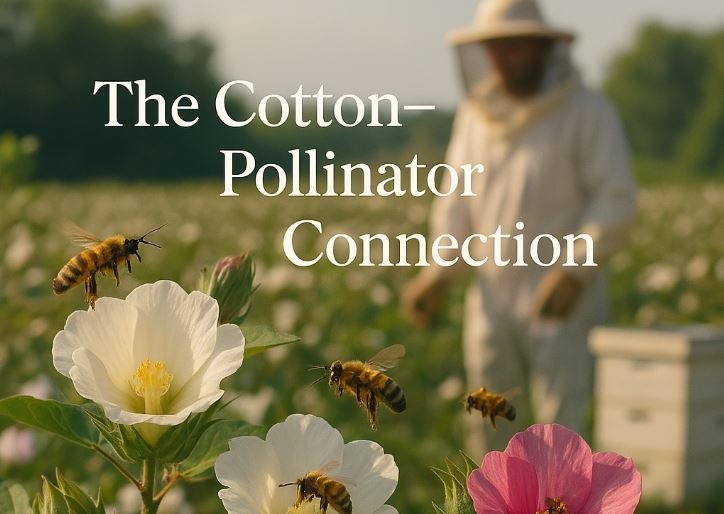
Cotton and Honeybees: A Beneficial Partnership for SC Growers
Share
The Cotton–Pollinator Connection
As we approach the peak of summer, one of South Carolina’s most important cash crops can be seen growing in fields across the Lowcountry and Midlands: cotton. The cotton plant is a member of the mallow family (Malvaceae), along with hibiscus, okra, and marsh mallow source.
(Fun fact: yes, the marsh mallow plant is the origin of the marshmallow confection. The roots were once used to make the treat.)
Plants in the mallow family have large, showy flowers that produce significant amounts of nectar, making them an important late-season food source for honeybees and native pollinators when few other nectar sources are available source.
Pollinators Help Boost Cotton Yields
Cotton is largely self-pollinating, but the structure and weight of its pollen make wind-based cross-pollination unlikely. Instead, insects like honeybees help improve fruit set and boll development by transferring pollen between flowers source.
Research has shown that cotton fields located near managed honeybee colonies can experience yield increases of up to 18–20%, along with larger and higher-quality bolls. This effect is especially noticeable during heavy bloom and when bee activity is strong source.
The Risk: Pesticides and Pollinators
Despite the potential benefits, this relationship is often disrupted by pesticide use. Cotton farmers rely heavily on insecticides to control green stink bugs, bollworms, and other damaging pests. However, many of these products are highly toxic to pollinators—especially during flowering, when bees are most active source.
Honeybee colonies kept within two miles of treated cotton fields may experience reduced foraging activity, brood loss, or even colony collapse. Native pollinators are also at risk, especially when foraging on wildflowers or other crops near cotton source.
Protecting Pollinators While Controlling Pests
The good news is that farmers can protect pollinators without sacrificing pest control. Research and extension services have outlined key best practices that reduce pesticide risk to bees and other beneficial insects.
Pesticide Application Tips for Cotton Farmers:
-
Avoid spraying during bloom. If possible, apply insecticides before or after peak flowering.
-
Spray in the evening or early morning. Pollinators are least active after sunset and before sunrise.
-
Use selective or lower-toxicity products when available and avoid broad-spectrum insecticides during bloom.
-
Watch the wind. Apply pesticides only when wind speeds are low to prevent drift onto adjacent flowering plants.
-
Communicate with nearby beekeepers. A heads-up before spraying gives them time to protect their colonies.
-
Follow label instructions carefully. Many pesticides include specific pollinator warnings—they matter.
For more in-depth guidance, the NC Department of Agriculture and UGA Extension offer excellent resources on pollinator-safe cotton practices.
A Win-Win for Farmers and Bees
When bees and cotton coexist, both benefit. Thoughtful pesticide management can help farmers maintain strong yields while supporting healthy pollinator populations. In a time when both cotton production and bee health face increasing challenges, this partnership is more valuable than ever.
